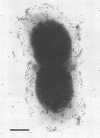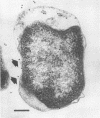Abstract
Three immunoelectron microscopy (IEM) methods were employed to show laboratory-cultivated Francisella tularensis. By the IEM assays, F. tularensis was distinguished from four antigenically distinct gram-negative bacteria. IEM should be a valuable tool for confirming presumptive isolates of F. tularensis and may potentially be useful for demonstrating other medically important bacteria.
Full text
PDF



Images in this article
Selected References
These references are in PubMed. This may not be the complete list of references from this article.
- Bevanger L., Maeland J. A., Naess A. I. Agglutinins and antibodies to Francisella tularensis outer membrane antigens in the early diagnosis of disease during an outbreak of tularemia. J Clin Microbiol. 1988 Mar;26(3):433–437. doi: 10.1128/jcm.26.3.433-437.1988. [DOI] [PMC free article] [PubMed] [Google Scholar]
- Bevanger L., Maeland J. A., Naess A. I. Competitive enzyme immunoassay for antibodies to a 43,000-molecular-weight Francisella tularensis outer membrane protein for the diagnosis of tularemia. J Clin Microbiol. 1989 May;27(5):922–926. doi: 10.1128/jcm.27.5.922-926.1989. [DOI] [PMC free article] [PubMed] [Google Scholar]
- Brown S. L., McKinney F. T., Klein G. C., Jones W. L. Evaluation of a safranin-O-stained antigen microagglutination test for francisella tularensis antibodies. J Clin Microbiol. 1980 Feb;11(2):146–148. doi: 10.1128/jcm.11.2.146-148.1980. [DOI] [PMC free article] [PubMed] [Google Scholar]
- Carlsson H. E., Lindberg A. A., Lindberg G., Hederstedt B., Karlsson K. A., Agell B. O. Enzyme-linked immunosorbent assay for immunological diagnosis of human tularemia. J Clin Microbiol. 1979 Nov;10(5):615–621. doi: 10.1128/jcm.10.5.615-621.1979. [DOI] [PMC free article] [PubMed] [Google Scholar]
- Forsman M., Sandström G., Jaurin B. Identification of Francisella species and discrimination of type A and type B strains of F. tularensis by 16S rRNA analysis. Appl Environ Microbiol. 1990 Apr;56(4):949–955. doi: 10.1128/aem.56.4.949-955.1990. [DOI] [PMC free article] [PubMed] [Google Scholar]
- Fulop M. J., Webber T., Manchee R. J., Kelly D. C. Production and characterization of monoclonal antibodies directed against the lipopolysaccharide of Francisella tularensis. J Clin Microbiol. 1991 Jul;29(7):1407–1412. doi: 10.1128/jcm.29.7.1407-1412.1991. [DOI] [PMC free article] [PubMed] [Google Scholar]
- Geisbert T. W., Jahrling P. B., Hanes M. A., Zack P. M. Association of Ebola-related Reston virus particles and antigen with tissue lesions of monkeys imported to the United States. J Comp Pathol. 1992 Feb;106(2):137–152. doi: 10.1016/0021-9975(92)90043-t. [DOI] [PubMed] [Google Scholar]
- Geisbert T. W., Rhoderick J. B., Jahrling P. B. Rapid identification of Ebola virus and related filoviruses in fluid specimens using indirect immunoelectron microscopy. J Clin Pathol. 1991 Jun;44(6):521–522. doi: 10.1136/jcp.44.6.521. [DOI] [PMC free article] [PubMed] [Google Scholar]
- Karlsson K. A., Dahlstrand S., Hanko E., Söderlind O. Demonstration of Francisella tularensis (syn. Pasteurella tularensis) in sylvan animals with the aid of fluorescent antibodies. Acta Pathol Microbiol Scand B Microbiol Immunol. 1970;78(5):647–651. doi: 10.1111/j.1699-0463.1970.tb04351.x. [DOI] [PubMed] [Google Scholar]
- OVERHOLT E. L., TIGERTT W. D., KADULL P. J., WARD M. K., CHARKES N. D., RENE R. M., SALZMAN T. E., STEPHENS M. An analysis of forty-two cases of laboratory-acquired tularemia. Treatment with broad spectrum antibiotics. Am J Med. 1961 May;30:785–806. doi: 10.1016/0002-9343(61)90214-5. [DOI] [PubMed] [Google Scholar]
- Syrjälä H., Koskela P., Ripatti T., Salminen A., Herva E. Agglutination and ELISA methods in the diagnosis of tularemia in different clinical forms and severities of the disease. J Infect Dis. 1986 Jan;153(1):142–145. doi: 10.1093/infdis/153.1.142. [DOI] [PubMed] [Google Scholar]






